Beneath the seemingly innocent surface of paid search, monstrous errors could be lurking. If your paid search efforts aren’t performing the way they could, should or did, gather ‘round to hear these true stories of disastrous decisions from our own case studies.
As anyone who’s ever built a bridge, driven at speeds greater than 100 mph, or owned a spine can attest, alignment is extremely important. There must be a smooth connection between goals at every level, from the C suite down to ad spend decisions. Otherwise, you might come face to face with…
The Sickeningly Misshapen Offspring of Misaligned Goals
One of our clients experienced a fateful mismatch between company goals and marketing spend. Senior management at this large provider of mobile offices and storage containers had established these priorities:
- Primary customer acquisition focus: businesses searching for mobile offices
- Secondary customer acquisition focus: businesses searching for storage containers
- Not interested in: PODS, residential, or retail customers
Given these priorities, the expected marketing spend allocation would look something like this:
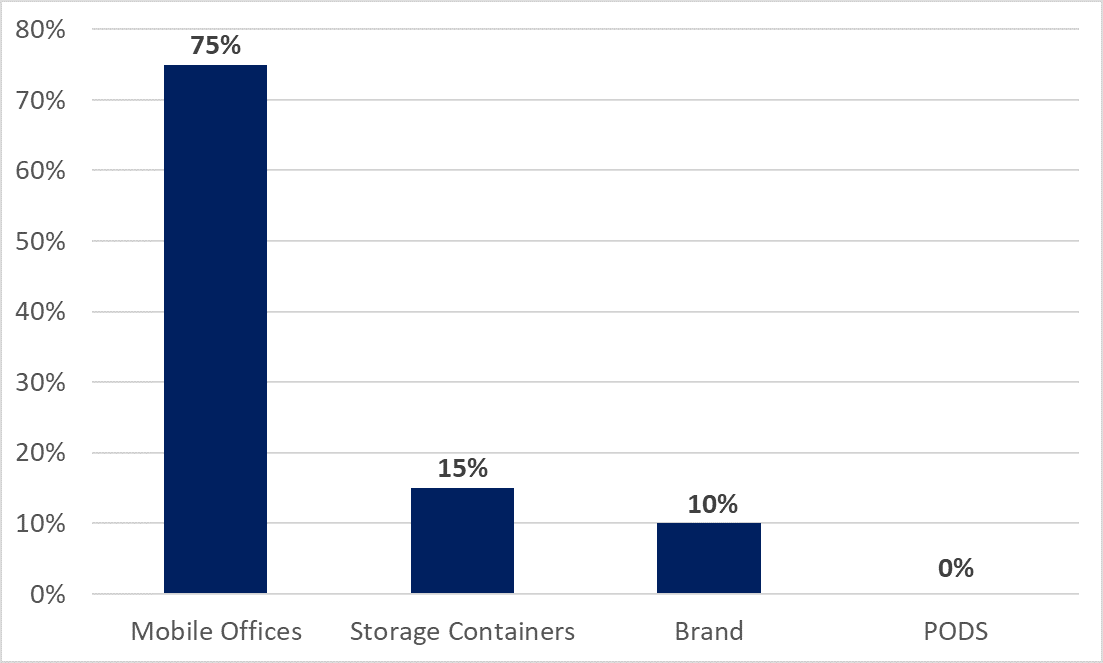
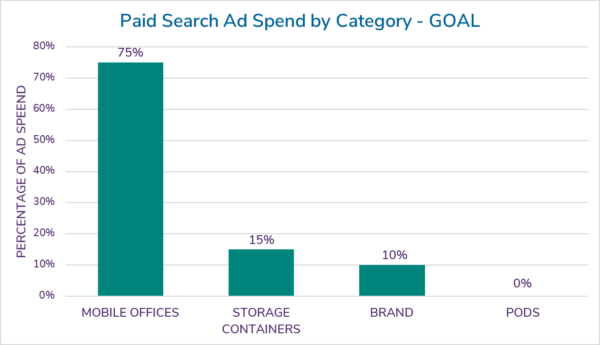
However, their actual paid search spend revealed a more disturbing truth:
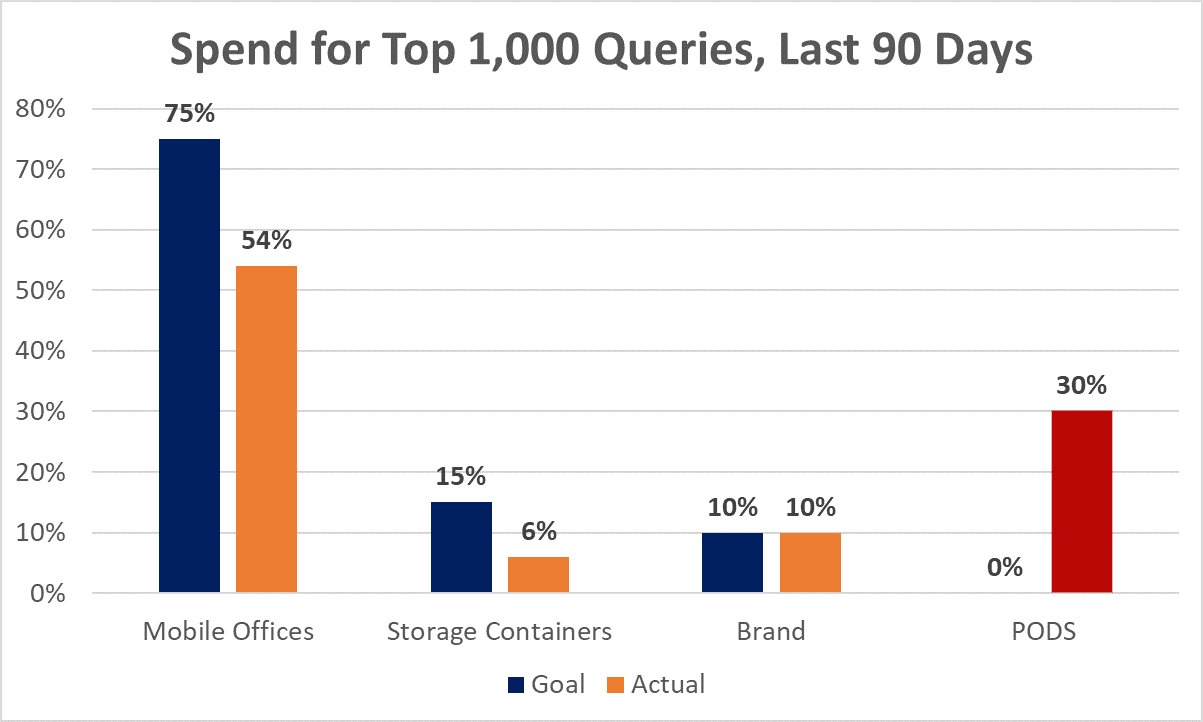
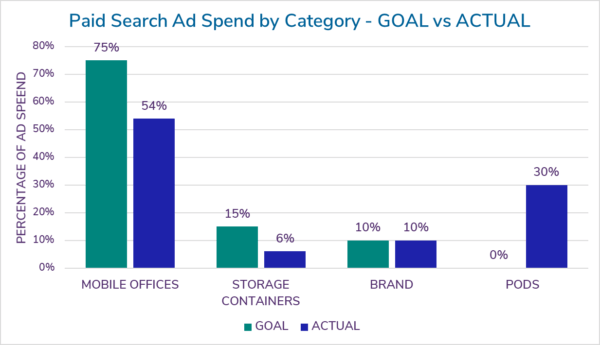
How could something so horrifying have happened? Through the nightmare of misaligned goals. The marketing team’s success was measured by number of leads and cost per lead, and their goals were to acquire 2,500 leads a month at $40 a lead with a monthly budget of $100,000.
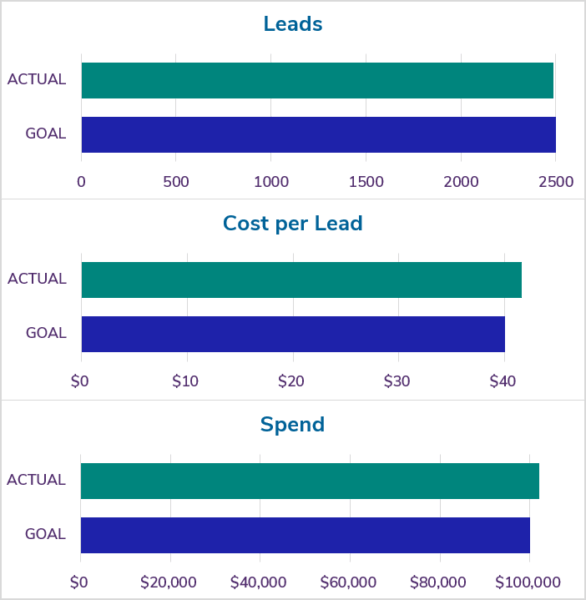
Given these goals, the marketing team was pretty much on target. However, those goals weren’t linked to the company’s strategy, so they were spending about $30,000 a month on leads for customers that weren’t in the company’s target markets.
All leads are not created equal, so merely setting a target number of leads without regard for the quality and strategic value of those leads is like inviting the Sickeningly Misshapen Offspring of Misaligned Goals to your slumber party.
The Sickeningly Misshapen Offspring of Misaligned Goals II: When Apples Met Oranges
Like many horror stories, this one has a sequel. Once again, the marketing team’s winning performance was hiding a fatal flaw, one that could doom the company.
Your company, not unlike a vampire, needs a steady influx of fresh blood – by which we mean new customers. Existing customers are great, of course, but the sad truth is that they’re not going to be around forever.
They could always change: products, platforms, needs, wants, jobs, countries; they could retire or actually pass away. Without new customers, your business will wither and decay like an unfed vampire.
Here’s one case of a company that decided to stop marketing to new customers. Instead, as their CFO proclaimed, “We are going to focus on our profitable brand keywords.” There’s only one problem with that, but it’s pretty major.
Brand keywords work best with searchers who are already familiar with your brand (i.e., existing customers). However, if your company is to stay relevant and profitable, you must also introduce your brand to searchers who aren’t familiar with you yet.
The company that focused on its brand keywords saw this trend over a year:
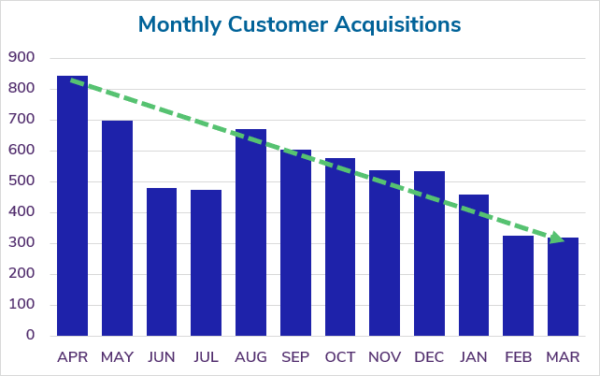
Their monthly customer acquisitions had dropped by a bone-chilling 62%.
However, acquiring new customers can be an arduous ordeal. Customer retention specialist Ian Kingwill estimates that “it costs between 4 and 10 times more to acquire a new customer than it does to keep an existing one.”
Existing customers are:
- More profitable
- Easier to find
- Easier to convert
- Simply not enough to maintain or grow your company
New customers are:
- More expensive to acquire
- Harder to find
- More difficult to convert
- Utterly essential for growth
Let us return to the scene of the original crime: the client haunted by the Sickeningly Misshapen Offspring of Misaligned Goals. While they were spending 30% of their monthly budget on keywords that ran counter to the company’s goals, at least they were spending 10% on brand terms, which was exactly in line with our recommendations.

Those brand terms delivered 38% of total leads at a cost per lead that was almost 75% lower than the team’s goal of $40. To review, though, these terms were aimed at existing customers rather than new ones. In fact, only 29% of total leads came from new customers. This wasn’t a path to long-term success, but to the pit where customer bases go to die.
However, once we adjusted their actual ad spend to match their goal ad spend, the majority of their leads came from new-customer-oriented keywords, meaning that the company was using digital marketing for growth.

Escaping the Nightmares
How can you dodge The Sickeningly Misshapen Offspring of Misaligned Goals?
- Clearly articulate overall company goals to your marketing team. Your team needs to understand the big picture, and how their achievements contribute to that.
- Make sure paid search spend is aligned with company goals. Do a spot check on ad spend to see if there’s any noticeable deviation.
- Set goals for your team that are not only aligned with company goals but are also very specific.
And how can you elude The Sickeningly Misshapen Offspring of Misaligned Goals II: When Apples Met Oranges?
- Set separate budgets and goals for new- and current-customer marketing activities. New customers will have higher acquisition costs; plan for it.
- Invest in new-customer drivers, such as top-of-the-funnel keywords, display advertising, and lead generation.
- When determining performance, compare leads and CPLs within new-customer groups, rather than against brand keywords.
In other words, by implementing a paid search consulting strategy, (un)Common Logic starts every client engagement with an in-depth discussion of business and marketing goals to ensure that The Sickeningly Misshapen Offspring of Misaligned Goals never rears its ugly head.
Coming next week… prepare yourself for Rise of the Scripts: The Strategy that Nearly Slaughtered Our ROI.
The Sickeningly Misshapen Offspring of Misaligned Goals
One of our clients experienced a fateful mismatch between company goals and marketing spend. Senior management at this large provider of mobile offices and storage containers had established these priorities:- Primary customer acquisition focus: businesses searching for mobile offices
- Secondary customer acquisition focus: businesses searching for storage containers
- Not interested in: PODS, residential, or retail customers

 However, their actual paid search spend revealed a more disturbing truth:
However, their actual paid search spend revealed a more disturbing truth:

 How could something so horrifying have happened? Through the nightmare of misaligned goals. The marketing team’s success was measured by number of leads and cost per lead, and their goals were to acquire 2,500 leads a month at $40 a lead with a monthly budget of $100,000.
How could something so horrifying have happened? Through the nightmare of misaligned goals. The marketing team’s success was measured by number of leads and cost per lead, and their goals were to acquire 2,500 leads a month at $40 a lead with a monthly budget of $100,000.
 Given these goals, the marketing team was pretty much on target. However, those goals weren’t linked to the company’s strategy, so they were spending about $30,000 a month on leads for customers that weren’t in the company’s target markets.
All leads are not created equal, so merely setting a target number of leads without regard for the quality and strategic value of those leads is like inviting the Sickeningly Misshapen Offspring of Misaligned Goals to your slumber party.
Given these goals, the marketing team was pretty much on target. However, those goals weren’t linked to the company’s strategy, so they were spending about $30,000 a month on leads for customers that weren’t in the company’s target markets.
All leads are not created equal, so merely setting a target number of leads without regard for the quality and strategic value of those leads is like inviting the Sickeningly Misshapen Offspring of Misaligned Goals to your slumber party.
The Sickeningly Misshapen Offspring of Misaligned Goals II: When Apples Met Oranges
Like many horror stories, this one has a sequel. Once again, the marketing team’s winning performance was hiding a fatal flaw, one that could doom the company. Your company, not unlike a vampire, needs a steady influx of fresh blood – by which we mean new customers. Existing customers are great, of course, but the sad truth is that they’re not going to be around forever. They could always change: products, platforms, needs, wants, jobs, countries; they could retire or actually pass away. Without new customers, your business will wither and decay like an unfed vampire. Here’s one case of a company that decided to stop marketing to new customers. Instead, as their CFO proclaimed, “We are going to focus on our profitable brand keywords.” There’s only one problem with that, but it’s pretty major. Brand keywords work best with searchers who are already familiar with your brand (i.e., existing customers). However, if your company is to stay relevant and profitable, you must also introduce your brand to searchers who aren’t familiar with you yet. The company that focused on its brand keywords saw this trend over a year: Their monthly customer acquisitions had dropped by a bone-chilling 62%.
However, acquiring new customers can be an arduous ordeal. Customer retention specialist Ian Kingwill estimates that “it costs between 4 and 10 times more to acquire a new customer than it does to keep an existing one."
Existing customers are:
Their monthly customer acquisitions had dropped by a bone-chilling 62%.
However, acquiring new customers can be an arduous ordeal. Customer retention specialist Ian Kingwill estimates that “it costs between 4 and 10 times more to acquire a new customer than it does to keep an existing one."
Existing customers are:
- More profitable
- Easier to find
- Easier to convert
- Simply not enough to maintain or grow your company
- More expensive to acquire
- Harder to find
- More difficult to convert
- Utterly essential for growth
 Those brand terms delivered 38% of total leads at a cost per lead that was almost 75% lower than the team’s goal of $40. To review, though, these terms were aimed at existing customers rather than new ones. In fact, only 29% of total leads came from new customers. This wasn’t a path to long-term success, but to the pit where customer bases go to die.
However, once we adjusted their actual ad spend to match their goal ad spend, the majority of their leads came from new-customer-oriented keywords, meaning that the company was using digital marketing for growth.
Those brand terms delivered 38% of total leads at a cost per lead that was almost 75% lower than the team’s goal of $40. To review, though, these terms were aimed at existing customers rather than new ones. In fact, only 29% of total leads came from new customers. This wasn’t a path to long-term success, but to the pit where customer bases go to die.
However, once we adjusted their actual ad spend to match their goal ad spend, the majority of their leads came from new-customer-oriented keywords, meaning that the company was using digital marketing for growth.

Escaping the Nightmares
How can you dodge The Sickeningly Misshapen Offspring of Misaligned Goals?- Clearly articulate overall company goals to your marketing team. Your team needs to understand the big picture, and how their achievements contribute to that.
- Make sure paid search spend is aligned with company goals. Do a spot check on ad spend to see if there’s any noticeable deviation.
- Set goals for your team that are not only aligned with company goals but are also very specific.
- Set separate budgets and goals for new- and current-customer marketing activities. New customers will have higher acquisition costs; plan for it.
- Invest in new-customer drivers, such as top-of-the-funnel keywords, display advertising, and lead generation.
- When determining performance, compare leads and CPLs within new-customer groups, rather than against brand keywords.

